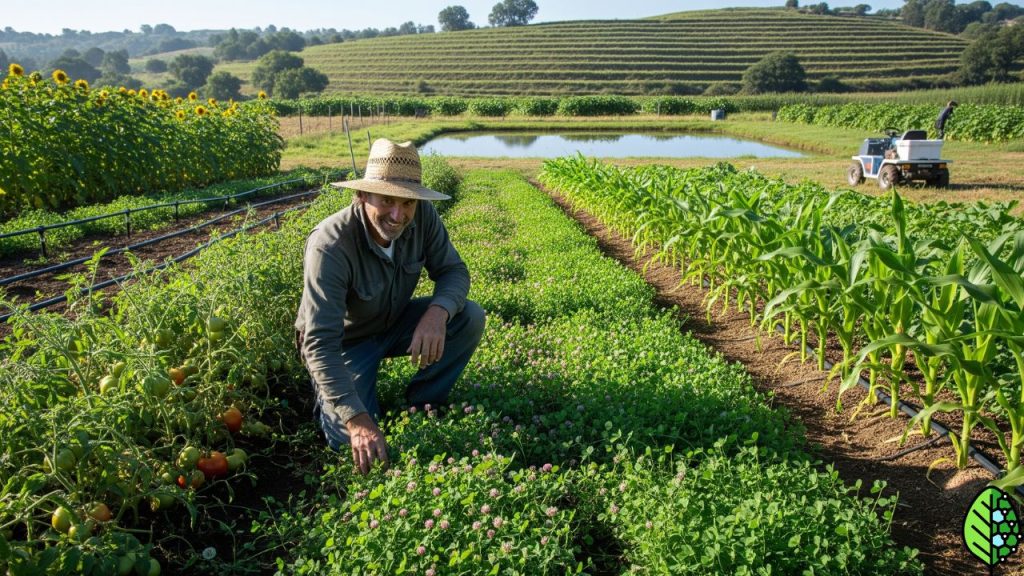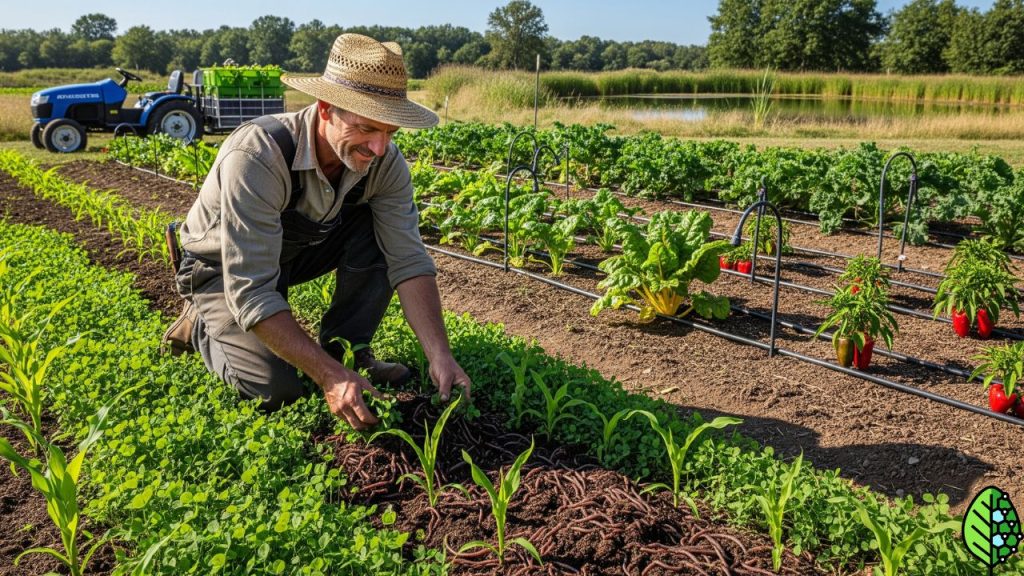Imagine walking through your farm, knowing that no matter what the weather throws your way, your crops and livestock will thrive. Sounds like a dream, right?
But this can be your reality. Building a climate-resilient farm is not just about protecting your livelihood; it’s about ensuring a sustainable future for generations to come. You might wonder, where do you even start? The answer is simpler than you think, and it’s more essential than ever.
As climate patterns shift, your farm’s ability to adapt could be the key to not just surviving but thriving. Dive in, and you’ll discover practical strategies and innovative solutions that will transform your farm into a resilient powerhouse. Ready to secure your farm’s future? Let’s get started.
Assessing Climate Risks
Crafting a climate-resilient farm involves evaluating environmental threats. Farmers can reduce risks by choosing adaptable crops. Implementing water conservation techniques and improving soil health also strengthen defenses against climate change.
Assessing climate risks is the cornerstone of building a climate-resilient farm. Understanding the specific threats posed by changing weather patterns and extreme events can help you make informed decisions. It’s about equipping your farm to withstand these challenges and thrive despite them.
Understanding Local Climate Patterns
Begin by researching the climate trends specific to your region. Are droughts becoming more frequent? Is there an increase in heavy rainfall? Local agricultural offices and weather stations often provide valuable data. Use this information to identify the most pressing risks to your farm.
Mapping Vulnerable Areas
Examine your farm to identify areas most susceptible to climate impacts. Low-lying fields might flood easily, while exposed hills could suffer from erosion. Create a detailed map highlighting these vulnerable zones. This visual tool can guide your efforts in reinforcing these areas.
Evaluating Crop Resilience
Assess which crops are most vulnerable to climate shifts. Some varieties may be more drought-resistant or flood-tolerant. Consider diversifying your crops to include those better suited to changing conditions. This strategy not only mitigates risk but can also enhance your yield.
Analyzing Water Resources
Water management is crucial in the face of climate change. Evaluate your current water sources and storage systems. Are they adequate during dry spells or heavy rains? You might need to invest in rainwater harvesting or efficient irrigation systems. These adjustments can safeguard your farm against fluctuating water availability.
Building Soil Health
Healthy soil is resilient soil. Conduct soil tests to understand its current state and improve it. Practices like cover cropping and reduced tillage can enhance soil structure and fertility. These methods help retain moisture during droughts and prevent erosion during storms.
Considering Financial Risks
Climate risks aren’t just physical; they have financial implications too. Calculate potential losses due to extreme weather events and assess your insurance coverage. Are you adequately protected? Exploring policies that cover climate-related damages can provide peace of mind.
Building a climate-resilient farm requires proactive planning and action. By thoroughly assessing climate risks, you can develop strategies that protect your farm and ensure its long-term viability. Are you ready to take the steps needed to safeguard your farm against climate uncertainties?
Implementing Sustainable Practices
Building a climate-resilient farm involves adopting sustainable practices like crop rotation and efficient water management. Farmers can increase soil health by using natural fertilizers and cover crops. These strategies help farms withstand climate challenges while supporting long-term productivity.

Implementing sustainable practices is a key step in building a climate-resilient farm. These practices not only help in adapting to the changing climate but also ensure the long-term productivity of your farm. By focusing on sustainability, you can reduce environmental impact and create a healthier ecosystem. Let’s explore some practical methods you can use to implement these practices effectively.
Conserve Water Wisely
Water is a precious resource, especially on a farm. Implement drip irrigation systems to deliver water directly to plant roots, reducing waste. Collect rainwater in barrels and use it during dry spells. Have you considered mulching? It helps retain soil moisture and reduces evaporation.
Enhance Soil Health
Healthy soil is the backbone of any farm. Rotate your crops to prevent nutrient depletion and pest buildup. Introduce cover crops to improve soil structure and fertility. Composting organic waste can enrich the soil with nutrients and microorganisms.
Integrate Pest Management
Pest control doesn’t mean reaching for chemicals immediately. Encourage natural predators like ladybugs and birds to manage pest populations. Grow companion plants that repel pests naturally. Monitor pest levels regularly and intervene only when necessary.
Reduce Chemical Use
Relying heavily on chemicals can harm the environment. Test soil regularly to understand nutrient needs and apply fertilizers only when needed. Use organic fertilizers and pesticides as much as possible. Can you minimize tilling? It reduces soil disturbance and keeps carbon locked in.
Embrace Renewable Energy
Energy use can be a significant factor in farm sustainability. Solar panels can power your farm equipment and facilities. Wind turbines are another option if you have the space. Switching to renewable energy sources reduces your carbon footprint and can save money in the long run.
Foster Biodiversity
A diverse farm ecosystem is more resilient. Plant a variety of crops and include native species to attract beneficial insects. Maintain hedgerows and wildflower patches to support pollinators. A farm that teems with life can better withstand environmental stresses.
Implementing these sustainable practices can transform your farm into a resilient oasis. Small changes make a big difference over time. Are you ready to take the first step towards a sustainable future?
Enhancing Biodiversity
Enhancing biodiversity is vital for creating a climate-resilient farm. Diverse ecosystems support stronger and healthier crops. They help farms withstand unpredictable weather changes. Biodiversity enriches the soil and controls pests naturally. This reduces the need for chemical inputs. It also encourages pollinators, which are essential for crop yield. Implementing biodiversity practices can lead to sustainable and productive farms.
Encouraging Native Plant Species
Native plants adapt well to local climates. They require less water and care. Planting native species supports local wildlife and insects. This creates a balanced ecosystem on the farm. Native plants also improve soil health and fertility. They help prevent erosion during heavy rains.
Integrating Agroforestry Systems
Agroforestry combines trees with crops or livestock. This practice enhances biodiversity on farms. Trees provide shade and shelter for other species. They also improve soil structure and retain water. Agroforestry systems can boost crop production. They offer multiple benefits for farmers and the environment.
Creating Habitat Corridors
Habitat corridors connect different natural areas. They allow wildlife to move freely across the landscape. These corridors improve biodiversity by linking habitats. They support various species and promote genetic diversity. Habitat corridors can be hedgerows or strips of native vegetation.
Promoting Crop Rotation And Diversity
Crop rotation involves planting different crops in sequence. This practice reduces pest buildup and soil depletion. Diverse crops improve soil health and nutrient availability. Rotating crops breaks pest cycles and prevents disease spread. It leads to healthier and more resilient farms.
Fostering Pollinator-friendly Environments
Pollinators are crucial for farm productivity. Creating pollinator habitats encourages their presence. Planting flowers and reducing pesticides support pollinator health. Pollinators increase crop yields and enhance biodiversity. They are key to a thriving, resilient farm ecosystem.

Conclusion
Building a climate-resilient farm takes dedication and smart strategies. Start with understanding your local climate. Plant diverse crops to adapt to weather changes. Use sustainable practices like crop rotation and water conservation. These methods protect the farm and the environment.
Engage with local farming communities for shared knowledge. Stay informed about new techniques and technologies. Small steps lead to big impacts. Embrace change for a sustainable future. Your farm can thrive despite climate challenges. Keep learning and adapting. A resilient farm is possible with effort and commitment.



